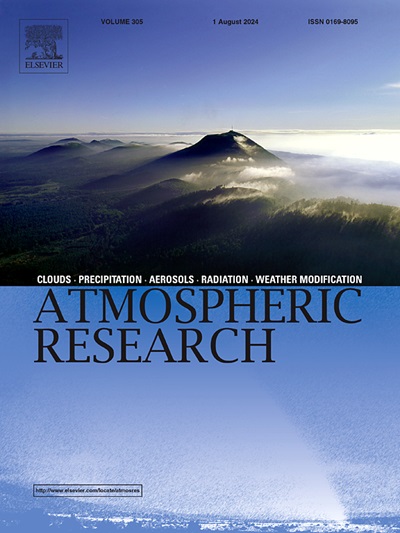Thermal effect of the Southeast Asian low-latitude highlands on interannual variability in the date of the Bay of Bengal summer monsoon onset
IF 4.5
2区 地球科学
Q1 METEOROLOGY & ATMOSPHERIC SCIENCES
引用次数: 0
Abstract
The timing of the Bay of Bengal summer monsoon (BOBSM) onset has implications for the evolution of the Asian summer monsoon and associated precipitation. This study employs Japanese 55-year Reanalysis and NOAA's Gridded Precipitation Reconstruction over Land data to explore the spatiotemporal variation in the thermal influence of the Southeast Asian low-latitude highlands (SEALLH) and its effect on the BOBSM onset date. There is a significant correlation between pre-monsoon season (February–April) shortwave radiative heating (SWH) in the SEALLH and BOBSM onset in the interannual time scale. During the enhanced SWH, an anomalous vertical circulation, which converges and ascends in the lower troposphere over the SEALLH and converges and descends in the upper troposphere north of the Bay of Bengal (BOB), develops over the SEALLH–north of BOB during the pre-monsoon season with anticlockwise rotation. The warmer air mass resulting from the adiabatic heating is accumulated around the north of BOB by the insulation effect related to the anomalous vertical circulation. By facilitating the reversal of the land-sea thermal contrast, the warmer upper troposphere over the north of the BOB causes a 16-day earlier onset of the BOBSM than the case of weakened SWH. The findings shed light on subsequent research into the thermal effects of the SEALLH on Asian summer monsoon variability.
东南亚低纬度高原对孟加拉湾夏季季风开始日期年际变化的热效应
孟加拉湾夏季季风(BOBSM)开始的时间对亚洲夏季季风和相关降水的演变有影响。本研究利用日本 55 年再分析和 NOAA 的陆地网格降水重建数据,探讨了东南亚低纬度高地(SEALLH)热影响的时空变化及其对孟加拉湾夏季季风开始时间的影响。在年际时间尺度上,季风季节前(2 月至 4 月)东南亚低纬度高原短波辐射加热(SWH)与京承地震发生时间之间存在明显的相关性。在增强的 SWH 期间,孟加拉湾季前的对流层对流层东南部和对流层东南部以北的对流层对流层对流层对流层对流层东南部和对流层东南部以北形成了异常垂直环流,该环流在对流层低层汇聚并上升,在对流层高层汇聚并下降,并呈逆时针旋转。绝热加热产生的较暖气团通过与异常垂直环流有关的隔热效应积聚在孟加拉湾北部周围。由于促进了海陆热对比的逆转,BOB 北部较暖的对流层上部比 SWH 减弱的情况下提前 16 天开始出现 BOBSM。这些发现为随后研究东南暖流对亚洲夏季季风变率的热效应提供了启示。
本文章由计算机程序翻译,如有差异,请以英文原文为准。
求助全文
约1分钟内获得全文
求助全文
来源期刊

Atmospheric Research
地学-气象与大气科学
CiteScore
9.40
自引率
10.90%
发文量
460
审稿时长
47 days
期刊介绍:
The journal publishes scientific papers (research papers, review articles, letters and notes) dealing with the part of the atmosphere where meteorological events occur. Attention is given to all processes extending from the earth surface to the tropopause, but special emphasis continues to be devoted to the physics of clouds, mesoscale meteorology and air pollution, i.e. atmospheric aerosols; microphysical processes; cloud dynamics and thermodynamics; numerical simulation, climatology, climate change and weather modification.
 求助内容:
求助内容: 应助结果提醒方式:
应助结果提醒方式:


